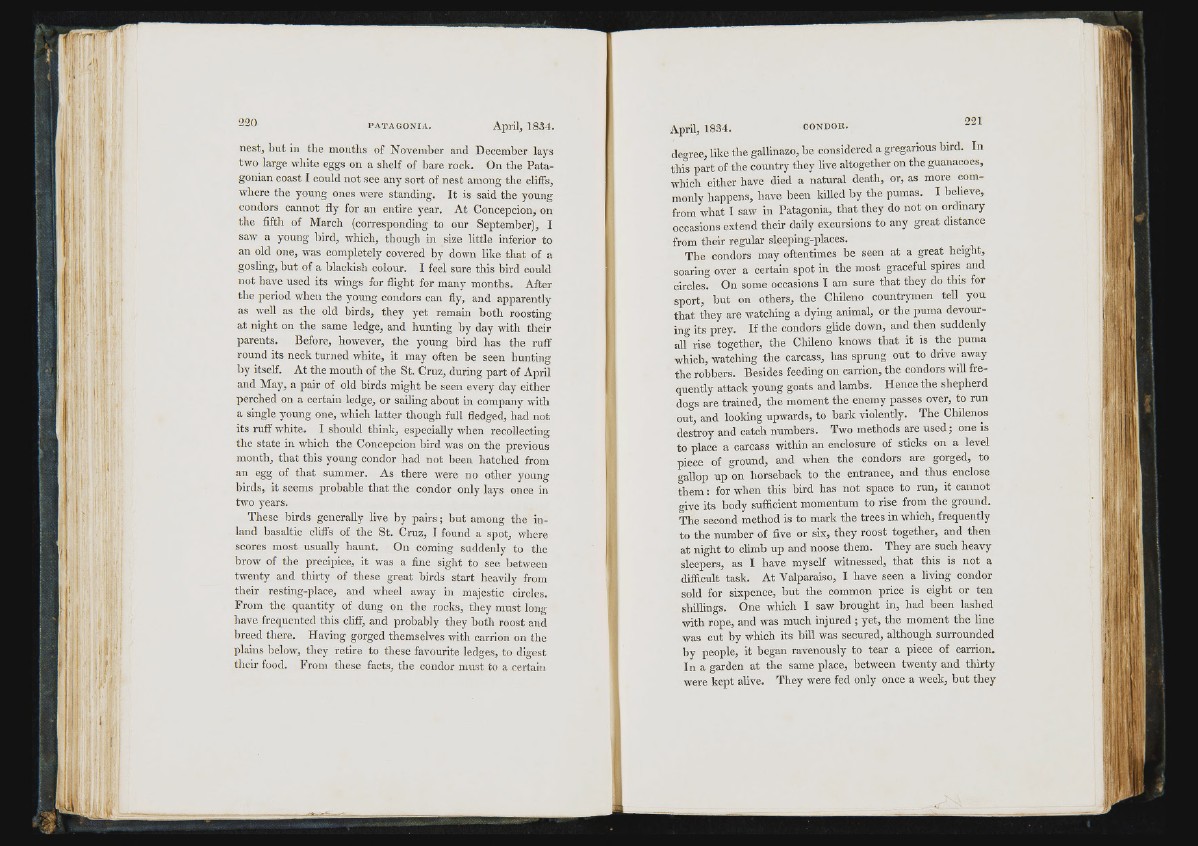
1 ■MI'-
1!
nest, but in the mouths of November and December lays
two large white eggs on a shelf of bare rock. On the Patagonian
coast I could not see any sort of nest among the cliffs,
where the young ones were standing. It is said the young
condors cannot fly for an entire year. At Concepcion, on
the fifth of March (corresponding to our September), I
saw a young bird, which, though in size little inferior to
an old one, was completely covered by down like that of a
gosling, but of a blackish colour. I feel sure this bird could
not have used its wings for flight for many months. After
the period when the young condors can fly, and apparently
as well as the old birds, they yet remain both roosting
at night on the same ledge, and hunting by day with their
parents. Before, however, the young bird has the ruff
round its neck turned white, it may often be seen hunting
by itself. At the mouth of the St. Cruz, during part of April
and May, a pair of old birds might be seen every day either
perched on a certain ledge, or sailing about in company with
a single young one, which latter though full fledged, had not
its ruff white. I should think, especially when recollecting
the state in which the Concepcion bird was on the previous
month, that this young condor had not been hatched from
an egg of that summer. As there were no other young
birds, it seems probable that the condor only lays once in
two years.
These birds generally live by pairs; but among the inland
basaltic cliffs of the St. Cruz, J found a spot, where
scores most usually haunt. On coming suddenly to the
brow of the precipice, it was a fine sight to see lietween
twenty and tliirty of these great birds start heavily from
their resting-place, and wheel away in majestic circles.
From the quantity of dung on the rocks, they must long
have frequented this cliff, and probably they both roost and
breed there. Having gorged themselves with carrion on the
plains below, they retire to these favourite ledges, to digest
their food. From these facts, the condor must to a certain
dcvree, like the gallinazo, be considered a gregarious bird. In
this part of the country they live altogether on the guanacoes,
which either have died a natural death, or, as more commonly
happens, have been kiUed by the pumas. I believe,
from what I saw in Patagonia, that they do not on ordinary
occasions extend their daily excursions to any great distance
from their regular sleeping-places.
The condors may oftentimes be seen at a great height,
soaring over a certain spot in the most graceful spires and
circles. On some occasions I am sure that they do this for
sport, but on others, the Chileno countrymen tell you
that they are watching a dying animal, or the puma devouring
its prey. If the condors glide down, and then suddenly
aUrise together, the Chileno knows that it is the puma
which, watching the carcass, has sprung out to drive away
the robbers. Besides feeding on carrion, the condors will frequently
attack young goats and lambs. Hence the shepherd
dogs are trained, the moment the enemy passes over, to run
out, and looking upwards, to bark violently. The Chilenos
destroy and catch numbers. Two methods are used; one is
to place a carcass within an enclosure of sticks on a level
piece of ground, and when the condors are gorged, to
gallop up on horseback to the entrance, and thus enclose
them: for when this bird has not space to run, it cannot
give its body sufficient momentum to rise from the ground.
The second method is to mark the trees in which, frequently
to the number of five or six, they roost together, and then
at night to climb up and noose them. They are such heavy
sleepers, as I have myself witnessed, that this is not a
difficult task. At Valparaiso, I have seen a living condor
sold for sixpence, hut the common price is eight or ten
shillings. One which I saw brought in, had been lashed
with rope, and was much injured; yet, the moment the line
was cut by which its bill was secured, although surrounded
by people, it began ravenously to tear a piece of carrion.
In a garden at the same place, between twenty and thirty
were kept alive. They were fed only once a week, but they
i l '